August 24th Scots Book of Days
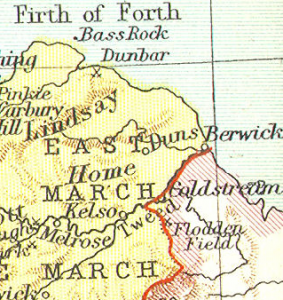 August 24 circa 70 Bartholomew the Apostle feast day.
August 24 circa 70 Bartholomew the Apostle feast day.
1198 – King Alexander II of Scotland born (d. 1249)
1217 Louis VIII of France. the Lion, the auld alliance with Scots, naval forces defeated by English off the coast of Sandwich on 24 August 1217, Louis was forced to make peace on English terms.
1289 Patrick de Dunbar, 7th Earl of Dunbar & March died. Lord of the feudal barony of Dunbar and its castle, which dominated East Lothian, and the most important military personage in the Scottish Borders.
Dunbar on the south coast of the Firth of Forth, on the North Sea. Top of the map shows the East March. Dunbar is about 25 miles from the border with England. Observe home of Caln of Lindsay, Caln of Home. Other locations are Berwick, Coldsrteam, Flodden Field, the River Tweed, and Melrose.
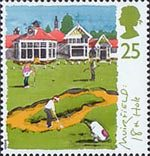 1994 www.collectgbstamps.co.uk, Golf Course commemoratives. Home of the Honourable Company of Edinburgh Golfers Duncur Road, Muirfield, Gullane, East Lothian, Scotland.
1994 www.collectgbstamps.co.uk, Golf Course commemoratives. Home of the Honourable Company of Edinburgh Golfers Duncur Road, Muirfield, Gullane, East Lothian, Scotland.
1456 – The printing of Gutenberg’s Bible is completed in Mainz or Mayence, then the Free Imperial City of the Holy Roman Empire (1244-1462), later Rhein-Hesse, moving between French and German governments. Movable type, and the printing press, reduce the cost of printing to one percent of the cost of hand scription (i.e. 100 printed Bibles cost the same as one written Bible). Within 50 years, Scotland’s parliament passes a law that all boys must be able to read and write (assumed to be instructed by their mother’s at home). A printing press is imported to Scotland about 1507, figuratively flooding the upper classes with Bibles. And 50 years thereafter, (1558) the Protestant Reformation is a fact in Scotland.
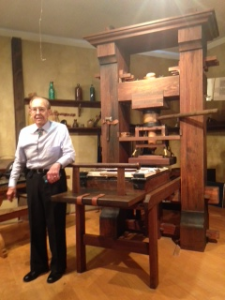 Provo Utah. Gutenburg’s Printing Press working replica with Lou Crandall as Gutenburg. Crandall Historical Printing Museum. The Museum is located at 275 Center Street, and call 801-377-7777 for tour reservations. Really, really worth the visit.
Provo Utah. Gutenburg’s Printing Press working replica with Lou Crandall as Gutenburg. Crandall Historical Printing Museum. The Museum is located at 275 Center Street, and call 801-377-7777 for tour reservations. Really, really worth the visit.
1482 Capture of Berwick (1482) Berwick-Upon-Tweed, Duke of Gloucester, The future Richard III led an army to take the town and castle of Berwick. It has remained English ever since.
Berwick upon Tweed as of 1402, Yellow is Scots, Blue is Bishopric of Durham.
Berwick upon Tweed as of 1900. At Tweedmouth.
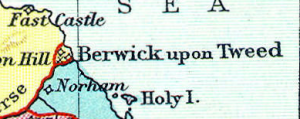 1539 The Little Unicorn was commissioned for her maiden voyage to the Isle of May and Dundee on 24 August 1539, accompanied by the Unicorn and the Mary Willoughby.
1539 The Little Unicorn was commissioned for her maiden voyage to the Isle of May and Dundee on 24 August 1539, accompanied by the Unicorn and the Mary Willoughby. 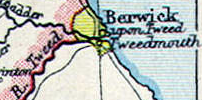 After the trip her guns including one medium culverin, two small falcons, and 24 hagbuts, were returned to the (James V) King’s Wark in Leith. The Unicorn and the Mary Willoughby were armed from the stores of Edinburgh Castle and cruised for pirates in the Summer of 1539.
After the trip her guns including one medium culverin, two small falcons, and 24 hagbuts, were returned to the (James V) King’s Wark in Leith. The Unicorn and the Mary Willoughby were armed from the stores of Edinburgh Castle and cruised for pirates in the Summer of 1539.
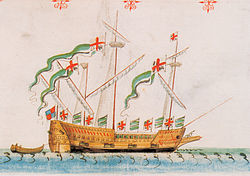 The captured Unicorn in the English Anthony Roll.
The captured Unicorn in the English Anthony Roll.
1542 Battle of Haddon Rig. Anglo-Scottish Wars. 3 miles east of Kelso, in the Scottish Borders, between Scotland and England on August 24, 1542, during the reign of King James V of Scotland. The English army was led by Robert Bowes, Deputy Warden of the English East March. It was a significant Scottish victory, under George Gordon, 4th Earl of Huntly, Commander and leader. See the map at 1289 above, Kelso is on the River Tweed in the lower third of the map.
1565 Letter from James Hamilton, duke of Châtelherault and James Stewart, earl of Moray, to Glenorchy. GD112/39/4/17 24 August 1565, Ayr.
…..
| Letter of 24 August 1565 | More modern version |
| ‘To our traist freynd the Lard of Glenwrquhy Traist freynd after our maist hartly commendatioun. Forsamekle as we haif understand therle of Argyille your chief hes tayn grytt paynis to address ane agreance betuix ye and your nychtbouris and now hes brought hyme to guid and raisonable termis and sic as we belief sall satisfye you. Quhairof as we ar maist rejoysed for your wele and dywerss uthersis causes sa on uther part we will maist ernistly craif of ye as your faythfull freyndis that ye wil be conformable and nocht lett so guid ane occasion of concord slyp for any small or tryfilling matter albeyt it suld evyn seame sumquhat in the raisonable menis syght. But rather consyddr the tyme and in quhat cace your cheifis house and your awin bayth with ws your freyndis presently standis. And pretermytt nocht sa guid ane occasion quharby ye accommodate your self and all your freyndis and annoy and hurt your enymies. And quhair uther thingis will nocht move ye lett our respectis and maist ernist requeistis move you | To our truest friend the Lord of Glenorchy. Truest friend after our Most hearty commendation. Forasmuch as we have [to] understand The Earl of Argyll* your chief has taken Great pains to address a grievance Between ye and your neighbors and Now has brought him to good and Reasonable terms and such as we believe Shall satisfy you. Whereof as we are Most rejoiced for your well and Diverse other causes so on other Part we will most earnestly craft of you As your faithful friend that ye will Be comfortable and not let so Good an occasion of concord slip For any small and trifling matter, albeit Should even seem somewhat in the Reasonable men’s sight. But rather Consider the time and in what case Your chief house and your own Both with us your friends presently Stands. And pretermit** not so Good an occasion whereby you Accommodate your self and all your Friends and annoy and hurt your Enemies. And where other things Will not move ye let our respect And most ernest request move ye …
|
| **pretermit – verb -omit to do or mention ARCHIBALD CAMPBELL, 5th Earl of Argyll (1532 – 12 Sept 1573) | |
| Sir Colin Campbell, 4th Laird of Glenorchy, Argyllshire (1583) | |
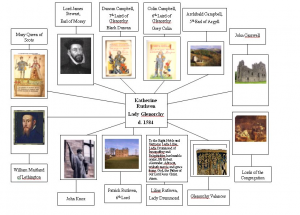 Katherine Ruthven (married SIR COLIN CAMPBELL, 4Thor or 6th LAIRD OF GLENORCHY before 15 June 1551.) Main Page
Katherine Ruthven (married SIR COLIN CAMPBELL, 4Thor or 6th LAIRD OF GLENORCHY before 15 June 1551.) Main Page
1566 RUTHVEN, WILLIAM, selected provost of Perth (ib. p. 505); fourth Lord Ruthven and first Earl of Gowrie (1541?–1584), second son of Patrick, third lord Ruthven [q. v.], by Janet Douglas, natural daughter of Archibald, earl of Angus, was born about 1541.
1700 The Darien colony. Sometime August. The failure of this favourite project, deep sorrow for the numbers who had fallen, many of whom were men of birth and blood, the regret for pecuniary losses, which threatened national bankruptcy, [Sir Walter Scott’s Tales of a Grandfather-59-47] and indignation at the manner in which their charter had been disregarded, all at once agitated from one end to the other a kingdom, which is to a proverb proud, 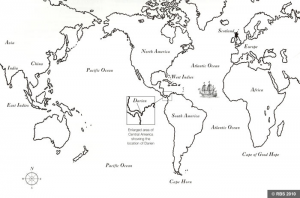 poor, and warm in their domestic attachments. Nothing could be heard throughout Scotland but the language of grief and of resentment. Indemnification, redress, revenge, were demanded by every mouth, and each hand seemed ready to vouch for the justice of the claim. For many years, no such universal feeling had occupied the Scottish nation. [The Isthismus of Panama could not be permanently settled because of Yellow Fever, a deadly disease; thus neither Spanish, nor natives, nor French, could control it. The cure had to wait until circa 1850 Pasteur’s theory of microbiology explained the disease, and then 1900 for Walter Reed to discover the vector of transmission in the mosquito spreading the deadly bug.]
poor, and warm in their domestic attachments. Nothing could be heard throughout Scotland but the language of grief and of resentment. Indemnification, redress, revenge, were demanded by every mouth, and each hand seemed ready to vouch for the justice of the claim. For many years, no such universal feeling had occupied the Scottish nation. [The Isthismus of Panama could not be permanently settled because of Yellow Fever, a deadly disease; thus neither Spanish, nor natives, nor French, could control it. The cure had to wait until circa 1850 Pasteur’s theory of microbiology explained the disease, and then 1900 for Walter Reed to discover the vector of transmission in the mosquito spreading the deadly bug.]
World map showing the location of Darien – www.rbs.com
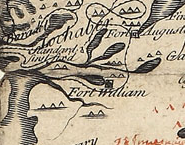 1745 Aug 24. PRINCE CHARLES EDWARD STUART Marched to Moy, crossing a hill to avoid a ship of war lying off Fort-William (I. 207).
1745 Aug 24. PRINCE CHARLES EDWARD STUART Marched to Moy, crossing a hill to avoid a ship of war lying off Fort-William (I. 207).
1814 – British victory at the Battle of Bladensburg in August 1814 allowed the British to capture and burn Washington, D.C. Alexander Forrester Inglis Cochrane born in 1758, and entered the Royal Navy. Cochrane rose to be admiral of the white, an MP (member parliament), and a Knight Grand Cross of the Bath. Commander of the North American Station. Died 1832. Public buildings burned. Tytler’s Britannica 274. General Ross lead the British Marines. The British stay in Washington until the 30th of August.
1816 Algiers. British fleet under Lord Exmouth bombard the port. Algiers had imprisoned the consul, massacred crews of Neapolitan and Corsican ships under the British flag. The British demanded liberation of all Christian slaves, and renounce slavery of Christian Europeans. Two thirds of the town were destroyed. Tytler’s Britannica 276-277.
1942 Saludos Amigos (Hello, Friends in English, Olá, Amigos in Portuguese) is a 1942 animated feature package film with Donald Duck (clan McDuck) in 2 segments. American tourist Donald Duck visits Lake Titicaca and meets with some of the local yokels, including an obstinate llama. Premier in Rio de Janeiro. Aquarela do Brasil (or “Watercolor of Brazil”), the finale of the film, has José Carioca, showing Donald Duck around South America and introducing him to the samba. Starring Lee Blair (artist clan Blair), Mary Blair (artist and Lee’s wife), William Norman “Norm” Ferguson (artist clan Ferguson), Frank Lee Graham (voice actor clan Graham).
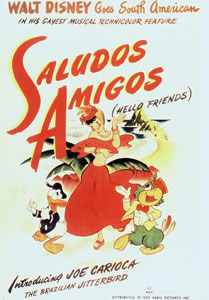 Poster. In early 1941, before U.S. entry into World War II, the United States Department of State commissioned a Disney goodwill tour of South America, intended to lead to a movie to be shown in the US, Central, and South America as part of the Good Neighbor Policy. Disney was chosen for this because several Latin American governments had close ties with Nazi Germany, and the US government wanted to counteract those ties. Donald Duck and other Disney characters were popular in Latin America, and Walt Disney acted as ambassador. The tour, facilitated by Nelson Rockefeller, who had recently been appointed as Coordinator of Inter-American Affairs (CIAA), took Disney and a group of roughly twenty composers, artists, technicians, etc. from his studio to South America, mainly to Brazil and Argentina, but also to Chile and Peru. The film itself was given federal loan guarantees, because the Disney studio had over-expanded just before European markets were closed to them by the war, and because Disney was struggling with labor unrest at the time (including a strike that was underway at the time the goodwill journey began)
Poster. In early 1941, before U.S. entry into World War II, the United States Department of State commissioned a Disney goodwill tour of South America, intended to lead to a movie to be shown in the US, Central, and South America as part of the Good Neighbor Policy. Disney was chosen for this because several Latin American governments had close ties with Nazi Germany, and the US government wanted to counteract those ties. Donald Duck and other Disney characters were popular in Latin America, and Walt Disney acted as ambassador. The tour, facilitated by Nelson Rockefeller, who had recently been appointed as Coordinator of Inter-American Affairs (CIAA), took Disney and a group of roughly twenty composers, artists, technicians, etc. from his studio to South America, mainly to Brazil and Argentina, but also to Chile and Peru. The film itself was given federal loan guarantees, because the Disney studio had over-expanded just before European markets were closed to them by the war, and because Disney was struggling with labor unrest at the time (including a strike that was underway at the time the goodwill journey began)
Disclaimer: The author of each article published on this web site owns his or her own words. The opinions, beliefs and viewpoints expressed by the various authors and forum participants on this site do not necessarily reflect the opinions, beliefs and viewpoints of Utah Standard News or official policies of the USN and may actually reflect positions that USN actively opposes. No claim in public domain or fair use. © John Choate
Utah Standard News depends on the support of readers like you.
Good Journalism requires time, expertise, passion and money. We know you appreciate the coverage here. Please help us to continue as an alternative news website by becoming a subscriber or making a donation. To learn more about our subscription options or make a donation, click here.
To Advertise on UtahStandardNews.com, please contact us at: ed@utahstandardnews.com.


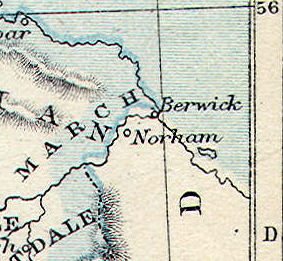
Comments - No Responses to “August 24th Scots Book of Days”
Sure is empty down here...